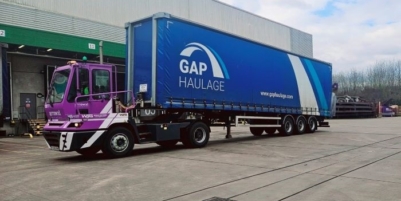-
Nutrivend selects Forterro’s Orderwise to support online expansion and streamline operations - April 11, 2025
-
ARROWXL LAUNCHES AMBITIOUS ZERO WASTE ROADMAP - April 8, 2025
-
THE BCMPA’S NEW CAMPAIGN DRIVES OUTSOURCING SUCCESS IN Q1 - April 7, 2025
-
BLACKOUT TECHNOLOGIES TARGETS TELEMATICS-INTEGRATED MOBILE DEVICE BLOCKING TO COMBAT SMARTPHONE DISTRACTION - April 1, 2025
-
OpenADR Alliance announces first OpenADR 3.0 certified products with EVoke Systems, E.ON Energy and Universal Devices - March 25, 2025
-
Growing fulfilment and contract packer appoints new Managing Director - March 25, 2025
-
When is it time to invest in a WMS? Understanding the key trigger points - March 25, 2025
-
eCapital helps Vantage Recruitment on its journey to financial success - March 24, 2025
-
Hugo Beck Celebrates 70 Years of Packaging Innovation with Open House Events - March 20, 2025
-
PROLOG FULFILMENT SUPPORTS LUNA DAILY’S COMMITMENT TO BETTER BODY CARE FOR ALL WOMEN - March 19, 2025
The challenges of a dynamic food sector require highly specified, flexible warehouse space – but where is it?
By Matt Whittaker, Commercial Director at Bis Henderson Space

When it comes to warehousing, the food sector presents many unique challenges. It can seem that almost every ingredient or product has different storage needs. Some have to stay cold – frozen, or in various ‘chilled’ regimes. Others, like bananas, have to be stored above a certain temperature. Chocolate blooms if the temperature fluctuates, and even ‘ambient’ goods need protecting against heat waves and cold snaps. Humidity may also be an issue. Many firms will require several different environmental regimes in the same facility, or in close proximity.
However, the challenges go far beyond temperature and humidity control. The sector is experiencing rapid change, with new demands, and this makes finding suitable storage facilities, that can be accessed on a flexible basis, a business-critical issue.
Increasingly the warehouse isn’t just for storage – it is a working operational environment, in which different areas are continuously accessed to pick, pack and dispatch combinations of fresh, long-life ambient, chilled and frozen goods, making maintaining the integrity of the differing environmental regimes much harder, while increasing the working area required. Facilities need to be designed around the need to meet onerous fulfilment timings (whether to supermarkets or home consumers), to operate FIFO easily, to allow segregation of products – to avoid cross-contamination, transfer of odours etc. – and to address other hygiene requirements.
Capacity requirements may be highly seasonal. Goods to meet Christmas or Easter demand are produced and warehoused through the year then pushed rapidly into the market. Conversely, produce such as broad beans are harvested and frozen over a very short season and marketed through the rest of the year. These ‘sawtooth’ patterns of supply and demand mean firms either pay for space that is underused for much of the time, or scramble for additional capacity to accommodate peaks.
Home delivery, and the related ‘recipe in a box’ approach, is now well established, while the hospitality trade and its suppliers have found new Direct to Consumer channels during the pandemic and will probably maintain these in more ‘normal’ times. Demand for ‘healthier’ and ‘fresher’ food means that, unlike much of manufacturing, the food sector is moving towards a more ‘Just in Time’ approach. Concerns around food standards, producer ethics, ‘air miles’ and support for localism have created opportunities for smaller and more specialist producers, whether through eCommerce or in the greater willingness of the multiples to stock more local or niche brands. As such companies outgrow the ‘farmhouse kitchen’ model, they increasingly require warehousing space, close to production and/or market.
The demand isn’t just from small producers: eCommerce has upped the requirements of major retailers, their suppliers and their 3PL partners, while supply chain uncertainties, from Brexit to Covid, mean firms are carrying higher levels of safety stock. And warehousing suitable for food grade operations is also in demand from the growing life sciences sector.
But, critically, new space is not coming to market in any quantity.
The reasons are not hard to find. For most investors and developers, the core product is four walls, a roof and a floor, with minimal if any fit out, which the user company can lease on a ten-year term and fit out to suit. The developer isn’t going to try to second-guess the, possibly unique, requirements of an as yet unknown food industry customer.
But many potential customers, often working on very fine margins, are in no position to commit to long leases, or to costly and time-consuming fit-outs. Even if they are, many new builds don’t meet the requirement. An efficient environmental regime needs high levels of insulation in roofs, walls and floors. Air circulation is important, as is ducting and cabling for environmental monitoring. There may be requirements for washing down vehicles, containers, transit packaging to food industry standards, so a need for more hard standing and possibly extra waste water treatment facilities. If not included in the initial build, these features cost time and money to retro-fit.
Bis Henderson Space has many food industry clients in urgent need of operational space, for a relatively short term. It may be while they see if their new business models work, or if their current growth is sustained, or perhaps, to accommodate growing seasonal peaks, or both. The traditional property market can’t really help, but we can access our extensive network of less ‘conventional’ suppliers – not in the property world but in the user community – to match up supply and demand, and manage this provision ‘as a service’. Not only can we help clients meet their capacity requirements, but by offering space as a managed service, we can help them avoid long-term balance sheet commitments.
Sometimes we are fortunate enough to be able to match up companies whose seasonal needs are conveniently out of phase. More often, though, it is a question of seeking out surplus space that can, with some thought, be adapted for the purpose.
We have, for example, worked with a multinational to temperature-control a large automated general merchandise warehouse by installing suitable chiller equipment and ducting. With another, in the confectionery business, we conducted a full site audit and implemented temperature measurement and monitoring systems at locations throughout the warehouse. The British Retail Confederation standard is a common certification for food industry warehousing – we work with our customers’ internal or external auditors to bring facilities up to the equivalent of the BRC badge, addressing issues such as the fabric of the building, pest control, or the capabilities of supplier systems to support FIFO, batch control.
In the current market we, and our clients, have to accept that the ideal solution simply may not be available. Occasionally, we have to advise our clients to bite the bullet and pay a competent 3PL for its services. Sometimes, our advice on addressing problems around ‘peaks’, or around very high outbound throughput requirements, may be to revisit the production cycle, or the operational procedures in the warehouse. More often, though, we can work with our clients and our space providers to find workable solutions.
Of course, there are aspects of food industry logistics where ‘compromise’ just isn’t an option, but often we can devise a solution that is perfectly viable over the duration of the requirement. Our advice, though, in such a tight market, is to move early to secure the space needed, and be prepared to have sensible commercial discussions with space providers. The requirement may well be short-term and tactical, but if companies talk to us early about their requirements – physical, environmental, geographical – we are in a much stronger position to help create a strategy tailored to your needs.
If any of the above resonates and you need support, please don’t hesitate to contact us to discuss potential solutions to the challenges you’re facing.

































